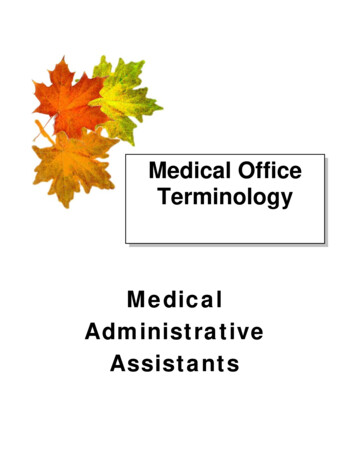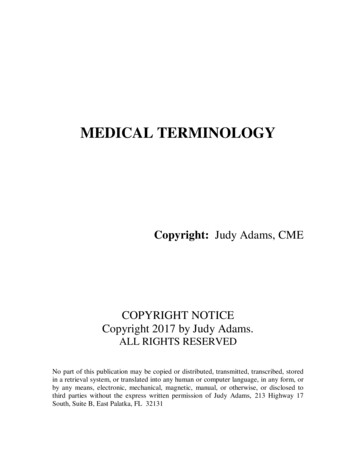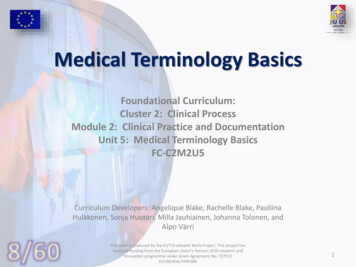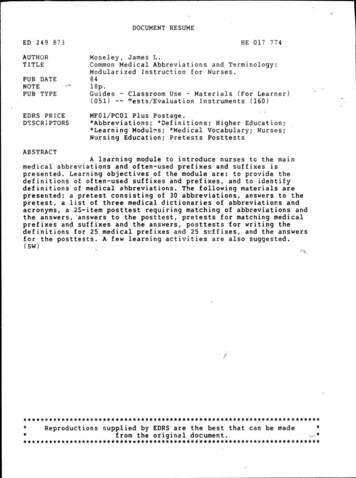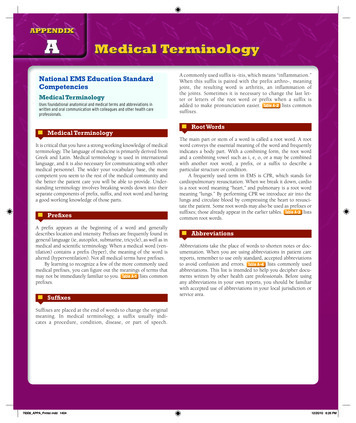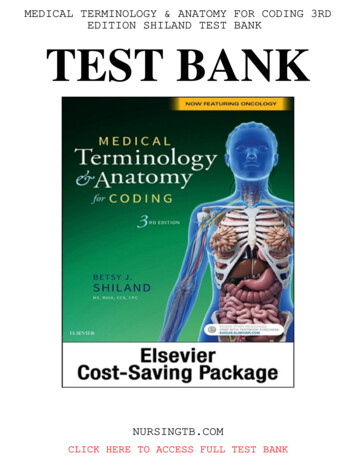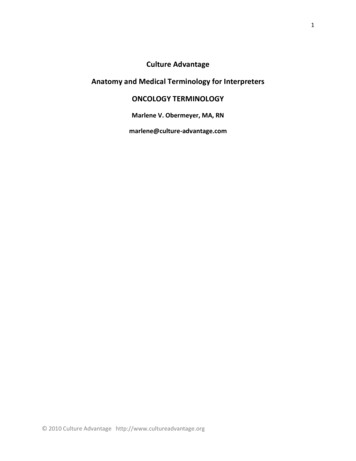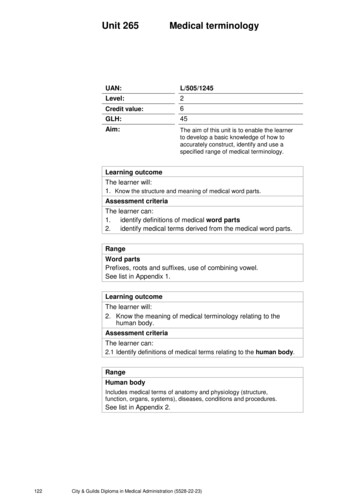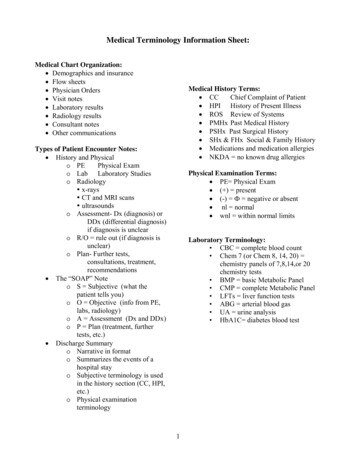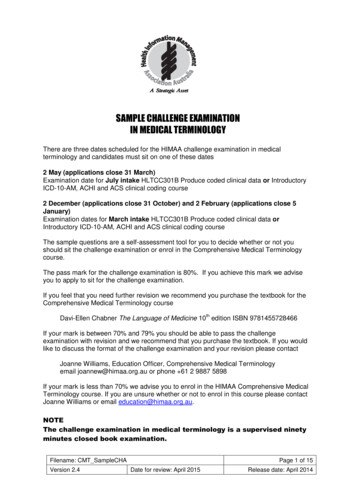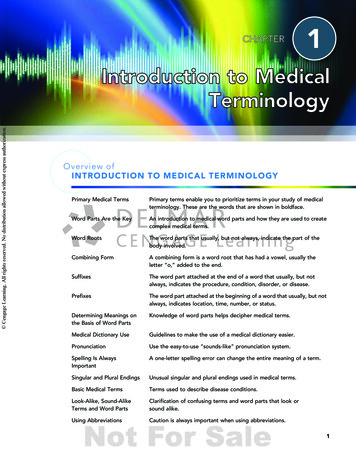
Transcription
CHAPTER1 Cengage Learning. All rights reserved. No distribution allowed without express authorization.Introduction to MedicalTerminologyOverview ofINTRODUCTION TO MEDICAL TERMINOLOGYPrimary Medical TermsPrimary terms enable you to prioritize terms in your study of medicalterminology. These are the words that are shown in boldface.Word Parts Are the KeyAn introduction to medical word parts and how they are used to createcomplex medical terms.Word RootsThe word parts that usually, but not always, indicate the part of thebody involved.Combining FormA combining form is a word root that has had a vowel, usually theletter “o,” added to the end.SuffixesThe word part attached at the end of a word that usually, but notalways, indicates the procedure, condition, disorder, or disease.PrefixesThe word part attached at the beginning of a word that usually, but notalways, indicates location, time, number, or status.Determining Meanings onthe Basis of Word PartsKnowledge of word parts helps decipher medical terms.Medical Dictionary UseGuidelines to make the use of a medical dictionary easier.PronunciationUse the easy-to-use “sounds-like” pronunciation system.Spelling Is AlwaysImportantA one-letter spelling error can change the entire meaning of a term.Singular and Plural EndingsUnusual singular and plural endings used in medical terms.Basic Medical TermsTerms used to describe disease conditions.Look-Alike, Sound-AlikeTerms and Word PartsClarification of confusing terms and word parts that look orsound alike.Using AbbreviationsCaution is always important when using abbreviations.1
2CHAPTER 1This list contains essential word parts and medicalterms for this chapter. These terms are pronounced inthe StudyWARETM and Audio CDs that are availablefor use with this text. These and the other importantprimary terms are shown in boldface throughout thechapter. Secondary terms, which appear in orangeitalics, clarify the meaning of primary terms.Word Parts&&&&&&&&&&&&&&&-algia pain, painful conditiondys- bad, difficult, or painful-ectomy surgical removal, cutting outhyper- excessive, increasedhypo- deficient, decreased-itis inflammation-osis abnormal condition, disease-ostomy the surgical creation of an artificialopening to the body surface-otomy cutting, surgical incision-plasty surgical repair-rrhage bleeding, abnormal excessive fluiddischarge-rrhaphy surgical suturing-rrhea flow or discharge-rrhexis rupture-sclerosis abnormal hardeningMedical Terms&&&&&&&&&&&&&&&abdominocentesis (ab-dom-ih-noh-sen-TEEsis)acronym (ACK-roh-nim)acuteangiography (an-jee-OG-rah-fee)appendectomy (ap-en-DECK-toh-mee)arteriosclerosis (ar-tee-ree-oh-skleh-ROH-sis)arthralgia (ar-THRAL-jee-ah)colostomy (koh-LAHS-toh-mee)cyanosis (sigh-ah-NOH-sis)dermatologist (der-mah-TOL-oh-jist)diagnosis (dye-ag-NOH-sis)diarrhea (dye-ah-REE-ah)edema (eh-DEE-mah)endarterial (end-ar-TEE-ree-al)eponym &&&&&&erythrocyte (eh-RITH-roh-sight)fissure (FISH-ur)fistula (FIS-tyou-lah)gastralgia (gas-TRAL-jee-ah)gastritis (gas-TRY-tis)gastroenteritis (gas-troh-en-ter-EYE-tis)gastrosis (gas-TROH-sis)hemorrhage (HEM-or-idj)hepatomegaly (hep-ah-toh-MEG-ah-lee)hypertension (high-per-TEN-shun)hypotension (high-poh-TEN-shun)infection (in-FECK-shun)inflammation (in-flah-MAY-shun)interstitial (in-ter-STISH-al)intramuscular (in-trah-MUS-kyou-lar)laceration (lass-er-AY-shun)lesion (LEE-zhun)malaise (mah-LAYZ)mycosis (my-KOH-sis)myelopathy (my-eh-LOP-ah-thee)myopathy (my-OP-ah-thee)myorrhexis (my-oh-RECK-sis)natal (NAY-tal)neonatology (nee-oh-nay-TOL-oh-jee)neurorrhaphy (new-ROR-ah-fee)otorhinolaryngology (oh-toh-rye-noh-lar-inGOL-oh-jee)palpation (pal-PAY-shun)palpitation (pal-pih-TAY-shun)pathology (pah-THOL-oh-jee)phalanges (fah-LAN-jeez)poliomyelitis (poh-lee-oh-my-eh-LYE-tis)prognosis (prog-NOH-sis)pyoderma (pye-oh-DER-mah)pyrosis (pye-ROH-sis)remissionsignsupination (soo-pih-NAY-shun)suppuration (sup-you-RAY-shun)supracostal (sue-prah-KOS-tal)symptom (SIMP-tum)syndrome (SIN-drohm)tonsillitis (ton-sih-LYE-tis)trauma (TRAW-mah)triage (tree-AHZH)viral (VYE-ral) Cengage Learning. All rights reserved. No distribution allowed without express authorization.Vocabulary Related to THE INTRODUCTION TO MEDICAL TERMINOLOGY
INTRODUCTION TO MEDICAL TERMINOLOGY3LEARNING GOALSOn completion of this chapter, you should be able to:5. Use the “sounds-like” pronunciation systemto correctly pronounce the primary termsintroduced in this chapter.1. Identify the roles of the four types of wordparts used in forming medical terms.2. Use your knowledge of word parts toanalyze unfamiliar medical terms.6. Recognize the importance of spellingmedical terms correctly.7. State why caution is important when usingabbreviations.4. Define the commonly used word roots,combining forms, suffixes, and prefixesintroduced in this chapter.8. Recognize, define, spell, and correctly pronounce the primary terms introduced in thischapter.PRIMARY MEDICAL TERMSWORD PARTS ARE THE KEYIn this book, you will be introduced to many medical terms;however, mastering them will be easier than you anticipatebecause this book has many features to make learning easier:Learning medical terminology is much easier once youunderstand how word parts work together to form medical terms (Figure 1.1). This book includes many aids tohelp you continue reinforcing your word-building skills.n Primary terms appear in boldface. Learning theseterms should be your highest priority as only primaryterms are used as correct answers in the LearningExercises and tests.n The types of word parts and the rules for their use areexplained in this chapter. Learn these rules and followthem.n Secondary terms appear in orange italics. Some ofthese terms are the “also known as” names for conditions or procedures. Other secondary terms clarifywords used in the definitions of primary terms.n When a term is made up of recognizable word parts,these word parts and their meanings are included withthe definition of that term. These word parts appear e-neur/o-gastr/o-b-suhypo- Delmar, Cengage Learning (2013) Cengage Learning. All rights reserved. No distribution allowed without express authorization.3. Describe the steps in locating a term in amedical dictionary.FIGURE 1.1 Word parts (word roots, combining forms, suffixes, and prefixes) make up most medical terms.
CHAPTER 1n The Learning Exercises for each chapter include a“Challenge Word Building” section to help developyour skills in working with word parts.n The Word Part Review follows Chapter 2. This sectionprovides additional word part practice and enablesyou to evaluate your progress toward mastering themeaning of these word parts.The Four Types of Word PartsThe four types of word parts used to create medical termsare: word roots, combining forms, suffixes, and prefixes. Guidelines for their use are shown in Table 1.1.1. A word root contains the basic meaning of the term.In medical terminology, this word part usually, but notalways, indicates the involved body part. For example,the word root meaning stomach is gastr.2. A combining form is a word root with a combiningvowel added at the end. For example, the combiningform meaning stomach is gastr/o. This form is usedwhen a suffix beginning with a consonant is added.When a combining form appears alone, it is shownwith a back slash (/) between the word root and thecombining vowel.n You’ll know a word part is a prefix when it is shownfollowed by a hyphen (-). For example, hyper- meansexcessive or increased.WORD ROOTSWord roots act as the foundation for most medical terms.They usually, but not always, describe the part of thebody that is involved (Figure 1.2). As shown inTable 1.2, some word roots indicate color.Play an interactive game labeling word partson your StudyWARE .Spinal cord(myel/o)3. A suffix usually, but not always, indicates the procedure, condition, disorder, or disease.n A suffix always comes at the end of the word. Cengage Learning. All rights reserved. No distribution allowed without express authorization.4Muscle(my/o)Bone(oste/o)n You’ll know a word part is a suffix when it is shownwith a hyphen (-) preceding it. For example, the suffix-itis means inflammation.4. A prefix usually, but not always, indicates location,time, number, or status.n A prefix always comes at the beginning of a word. A word root cannot stand alone. A suffixmust always be added at the end of theword to complete the term. The rules for creating a combining form byadding a vowel apply when a suffix beginning with a consonant is added to a wordroot. When a prefix is added, it is always placedat the beginning of the word.Nerve (neur/o)Joint (arthr/o) Delmar, Cengage Learning (2013)TABLE 1.1Word Part GuidelinesFIGURE 1.2 Word roots, shown here as combining forms,usually indicate the involved body part.
INTRODUCTION TO MEDICAL TERMINOLOGY5 Cengage Learning. All rights reserved. No distribution allowed without express authorization.TABLE 1.2Word Roots and Combining Forms Indicating Colorcyan/o means blueCyanosis (sigh-ah-NOH-sis) is blue discoloration of the skin caused by alack of adequate oxygen in the blood (cyan means blue, and -osis meansabnormal condition or disease).erythr/o means redAn erythrocyte (eh-RITH-roh-sight) is a mature red blood cell (erythr/omeans red, and -cyte means cell).leuk/o means whiteA leukocyte (LOO-koh-sight) is a white blood cell (leuk/o means white,and -cyte means cell).melan/o means blackMelanosis (mel-ah-NOH-sis) is any condition of unusual deposits of blackpigment in body tissues or organs (melan means black, and -osis meansabnormal condition or disease).poli/o means grayPoliomyelitis (poh-lee-oh-my-eh-LYE-tis) is a viral infection of the graymatter of the spinal cord (poli/o means gray, myel means spinal cord, and-itis means inflammation).Combining Forms VowelsA combining form includes the vowel that has beenadded to the end of a word root. For example, gastr/o isthe combining form of the word root for stomach. Theletter “o” is the most commonly used combining vowel,and under certain conditions, this is added to make theresulting medical term easier to pronounce. The rules forthe use of a combining vowel are:n When two word roots are joined, a combining vowel isalways added to the first word root. A combining vowelis used with the second word root only if the suffixbegins with a consonant.n For example, the term gastroenteritis combines twoword roots with a suffix: when gastr/o (stomach) isjoined with enter/o (small intestine), the combiningvowel is used with gastr/o.n The word root enter is joined to –itis without acombining vowel because this suffix begins with avowel. Gastroenteritis (gas-troh-en-ter-EYE-tis) is aninflammation of the stomach and small intestine.SUFFIXESA suffix is always added at the end of a word to complete thatterm. In medical terminology, suffixes usually, but not always,indicate a procedure, condition, disorder, or disease.A combining vowel is used when the suffix begins witha consonant. For example, when neur/o (nerve) is joinedwith the suffix -plasty (surgical repair) or -rrhaphy (surgical suturing), the combining vowel “o” is used because-plasty and -rrhaphy both begin with a consonant.n Neuroplasty (NEW-roh-plas-tee) is the surgical repairof a nerve.n Neurorrhaphy (new-ROR-ah-fee) is suturing togetherthe ends of a severed nerve.A combining vowel is not used when the suffix beginswith a consonant. For example, the word root tonsillmeans tonsils. The suffix that is added to complete theterm tells what is happening to the tonsils (Figure 1.3).n Tonsillitis (ton-sih-LYE-tis) is an inflammation of thetonsils (tonsill means tonsils, and -itis meansinflammation).n A tonsillectomy (ton-sih-LECK-toh-mee) is the surgicalremoval of the tonsils (tonsill means tonsils, and -ectomymeans surgical removal).Suffixes as Noun EndingsA noun is a word that is the name of a person, place, orthing. In medical terminology, some suffixes change theword root into a noun. For example, the cranium (KRAYnee-um) is the portion of the skull that encloses the brain(crani means skull, and -um is a noun ending). Othersuffixes complete the term by changing the word rootinto a noun. Suffixes that are commonly used as nounendings are shown in Table 1.3.
CHAPTER 1TONSILL(tonsil, tonsils) -ITIS(inflammation)TONSILLITIS(inflammation of the tonsils) Delmar, Cengage Learning (2013)6(gastr means stomach, and -osis means abnormalcondition or disease). Commonly used suffixes meaning“abnormal condition or disease” are shown in Table 1.5.TABLE 1.3Suffixes as Noun Endings-a-um-e-us-yTABLE 1.5Suffixes Meaning “Abnormal Condition”Suffixes Meaning “Pertaining To”An adjective is a word that defines or describes a thing. Inmedical terminology, many suffixes meaning “pertainingto” are used to change the meaning of the word root intoan adjective. For example, the term cardiac (KAR-dee-ack)is an adjective that means pertaining to the heart (cardimeans heart, and -ac means pertaining to). Commonlyused suffixes meaning “pertaining to” are shown inTable 1.4.TABLE 1.4Suffixes Meaning “Pertaining ary-ineSuffixes Meaning “AbnormalCondition”In medical terminology, many suffixes, such as -osis, mean“abnormal condition or disease.” For example, gastrosis(gas-TROH-sis) means any disease of the stomach-ago-iasis-esis-ion-ia-ism-osisSuffixes Related to PathologyPathology (pah-THOL-oh-jee) is the study of all aspectsof diseases (path means disease, and -ology means studyof). Suffixes related to pathology describe specific diseaseconditions.n -algia means pain and suffering. Gastralgia (gas-TRALjee-ah), also known as a stomachache, means painin the stomach (gastr means stomach, and -algiameans pain).n -dynia also means pain. Gastrodynia (gas-troh-DINee-ah) also means pain in the stomach (gastr/o meansstomach, and -dynia means pain). Although -dyniahas the s
In medical terminology, some suffixes change the word root into a noun. For example, the cranium (KRAY-nee-um) is the portion of the skull that encloses the brain (crani means skull, and -um is a noun ending). Other suffixes complete the term by changing the word root into a noun. Suffixes that are commonly used as noun endings are shown in Table 1.3. TABLE 1.2 Word Roots and Combining
